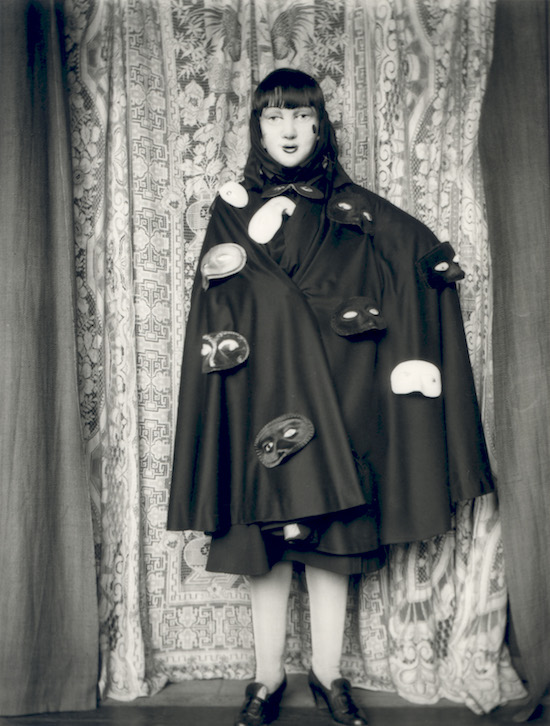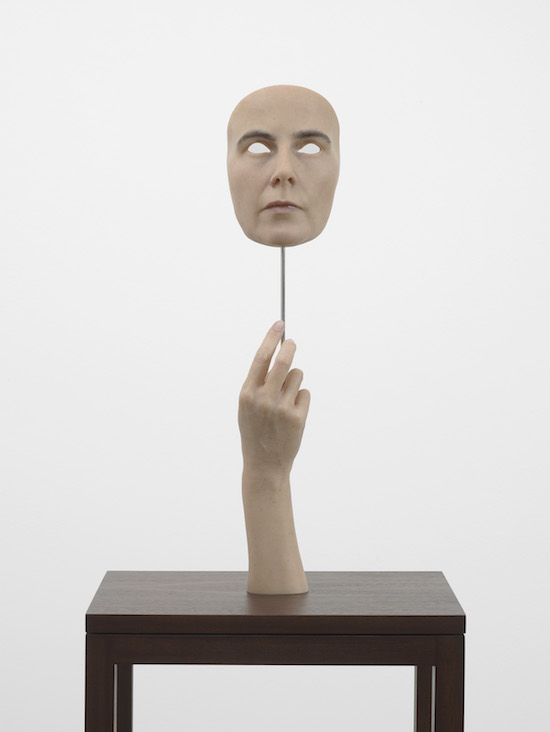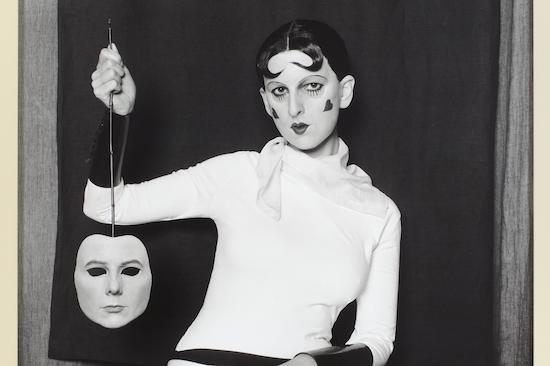Do masks ever reveal more than they conceal? And if the former, what is it they reveal? How the wearer might see themselves, rather than how others might perceive them? Or is it more to do with the way the viewer’s own perceptions are challenged and provoked by the mask-wearer? After all, masks can evoke all kinds of emotional responses, despite presenting a barrier. “Under this mask, another mask. I will never finish removing all these faces,” said Claude Cahun. She might have been challenging us with a simple refusal to be revealed, a wish to remain forever an enigma.
In fact, the French artist, who moved in the circle of André Breton years before he wrote the first Surrealist Manifesto in 1924, but who was already playing with Surrealist imagery, was only exposed to us at all after she’d long been dead. Her photographic portraits, taken by her artistic collaborator and life partner, Marcel Moore, were discovered and made public only some 30 years after she’d died in 1954. They were never intended as artistic statements to be viewed in galleries or published in books.
The images with which we are now familiar – the ones in which Cahun usually sports an almost bald head, as a “dandy”, or with cropped and dyed hair and wears stylish and androgynous clothes – almost never saw the light of day. Now she is celebrated for overturning gender binaries, well before the term ‘gender’ was anything other than a grammatical term.
She is also seen as the precursor to feminist performative artists such as Cindy Sherman, whose fame and importance at least coincides with Cahun’s own. This appears to prove that Cahun was “ahead of her time”. The Surrealists had always loved dressing up for the camera and playfully confounding sex roles, although this usually involved male artists dragged up as coquettish women or bourgeois matrons. None did it with the lifetime’s dedication of Cahun. We view her images as intrinsic to her self-identity, wrapped up in her sexuality.
None of this can be said of contemporary artist and one-time YBA Gillian Wearing, with whom Cahun is cast alongside in an often compelling, sometimes moving, but uneven exhibition at the National Portrait Gallery. And though its subtitle, Behind the Mask, Another Mask, is taken from Cahun’s quote, Cahun in fact usually appeared sans mask in her photographs. The ‘mask’ was merely her actor’s face and sense of theatre.

Self-portrait (full length masked figure in cloak with masks) by Claude Cahun, 1928; Jersey Heritage
Collections © Jersey Heritage
Not so with Wearing, whose plastic, or latterly unnervingly realistic silicon masks of famous artists and non-famous family members, obliterate any sense of Wearing herself. Often the resonances between the two feels forced, superficial rather than offering genuine dialogue regarding the nature of identity.
Here Wearing enacts a self-portrait by Robert Mapplethorpe, the one in which his head appears to be floating against a black background and in which he grips a death-skull cane, taken a year before he died of an AIDs-related illness in 1989; and there she is as her own three-year-old chubby-faced self, or several decades earlier as an 18-year-old in a photo which also recreates her teenage bedroom. And here she is as her brother, tattooed, bare-chested, and brushing his long, greasy-rocker hair. We know she’s behind there somewhere, behind this masquerade. It’s in the eyes, but the eyes are not windows to the soul. Only if you look very carefully do you find the artist imprisoned behind that rigid mask, since the only thing not seamless is the space around the eye sockets.
Unlike the younger artist, one never feels Cahun is imprisoned behind her various identities. Rather, one feels she is liberated by them – enacting various sides of herself, though the ambiguity between self and artifice is also what makes these images dynamic. These are aspects of Cahun’s performative self, and so the enigma remains intact.
Wearing copies, too, Cahun’s photograph in which the French artist is made up to look like a life-sized doll: rosebud lips, hearts tattooed on each pale cheek and greased-down kiss-curl hair. “I am in training/Don’t kiss me” reads a message on Cahun’s shirt, part of her circus strongman apparel which Cahun completes with a set of dumbbells resting on her lap. Instead of dumbbells, Wearing holds up a mask of her own face, and one can’t help but feel that again the game-playing around identity is a little self-conscious, a little too aware of itself. Still, it’s an arresting image, since Wearing blows up her photo to almost life-size, whereas Cahun’s original photo is tiny, barely bigger than a large postage stamp, as almost all her photographs are. One has to peer very closely, occupy this in-her-face intimate space, to even see the faded and silvery image properly.

Me as mask by Gillian Wearing, 2013; Private collection, courtesy Cecilia Dan Fine Art © Gillian Wearing, courtesy Maureen Paley, London; Regen Projects, Los Angeles; Tanya Bonakdar Gallery, New York
More visceral, inevitably, is a wall of images in which Wearing projects herself into various stages of her own old age, evincing as it does a genuine dread of mortality and passing youth, especially since, at points throughout this exhibition, we’re confronted by the youthful presence of the artist, both with a mask and without. Her Polaroid photos, which she began taking as a teenager, could have been lifted from any family album.
And it’s good to see an old friend in Wearing’s 1994 film Dancing in Peckham, in which the artist dances with increasing abandon in a Peckham shopping centre to music inside her head. She turns the heads of passersby, but Wearing is committed to the moment. The social mask has dropped; with her funny, amateur moves, she dances how we all dance in our bedrooms with the curtains drawn.
Dancing with abandon seems to have provided the YBAs with their best moments, from Tracey Emin to Sam Taylor-Johnson (née Taylor-Wood). And dancing in Jersey – where, in 1937, Cahun (who’d changed her name from Lucy Schwob) settled with Moore (who’d changed hers from Suzanne Malherbe) – is what she appears to be doing in a sequence of photos from 1949. Cahun and Moore both worked for the resistance after the Nazis occupied Jersey. When they were caught, they were both sentenced to death, though both survived and were released from prison shortly before the war’s end, when the Allied forces liberated the Channel Islands. Here she looks golden and ethereal against the sun, standing on a wall built by the occupiers. It’s the very image of liberation.
Gillian Wearing & Claude Cahun: Behind the mask, another mask, until 29 May, 2017 at the National Portrait Gallery


